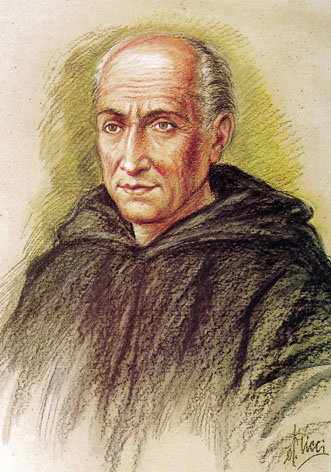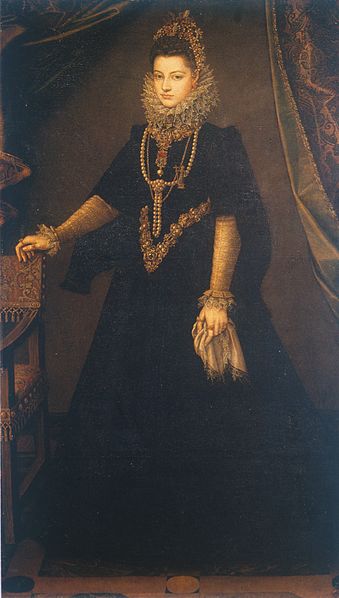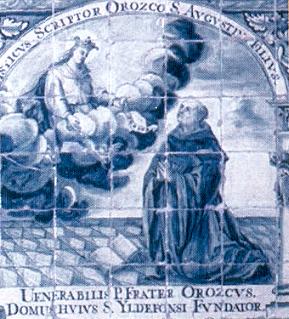Saint Alonso de Orozco Mena
Alphonsus de Orozco was born in Oropesa, Province of Toledo, Spain, on the 17th of October 1500, where his father was governor of the local castle. He began his studies in the nearby Talavera de la Reina and for three years he was a choir boy in the Cathedral of Toledo, where he made progress in the study of music. At the age of fourteen his parents sent him to the University of Salamanca, where an elder brother was already studying.
During the Lenten sermons preached by Thomas of Villanova in 1520, on the psalm “In exitu Israel de Aegipto”, his vocation to the religious life was brought to maturity and a little later, attracted by the religious atmosphere of the Friary of Saint Augustine, he entered that community, and there made his profession of vows at the hands of Saint Thomas of Villanova.
When ordained a priest in 1527 his superiors detected in him such deep spirituality and a capacity for proclaiming the Word of God, that very soon they appointed him to the ministry of preaching. From the age of thirty he held many offices, but in spite of his own austere life, his style of governing always showed him to be full of understanding. Inspired by a desire for martyrdom, he set off for Mexico as a missionary in 1549, but on his way, in the Canary Islands, he suffered a severe bout of arthritis and the doctors, fearing for his life, forbade him to continue his journey.
In 1554, when he was Prior of the Convent in Valladolid, a city which was for many decades the seat of the royal court, Alphonsus was appointed “royal preacher” to the court of the emperor Charles V. When the court was moved to Madrid in 1561, Alphonsus also had to move to the new capital of the Kingdom, and he took up his residence in the convent of Saint Philip the Royal.
In spite of the fact that he was now exercising an office which was outside the jurisdiction of his superiors and which also carried a stipend, he renounced all privileges and only wished to live as a humble friar in obedience to his superiors. He lived in austere poverty. He took only one daily meal at midday, he slept no more than three hours, because he said that was enough for the tasks of the new day. A table was his bed; cut vines his pillow. His room had just one chair, a candle, a broom and some books. By choice, the room was near the door so that he could better attend to the poor who used to come there to ask his help. Without neglecting his daily attendance in choir for prayer, he used to visit the sick in hospitals, the prisoners in the gaols and the poor in the streets and in their homes. He spent the day in prayer, in writing his books and preparing his sermons. He was very popular with members of every social class.
Personages of society and culture were witnesses in his process for canonisation, such as the Princess Isabel Clara Eugenia, the Dukes of Alba and of Lerma, the writer Lope de Vega, Francisco de Quevedo and González Dávila. Association with the upper classes did not divert him from his simple lifestyle. His fame spread throughout Madrid. The people who used to call him, much to his displeasure, the “saint of Saint Philip’s”, loved him for his gentle sensitivity in getting close to everyone without distinction.
He wrote many works, both in Latin as well as in Spanish. The simplicity of the titles indicate that they were written with a view to pastoral ministry: Rule for a Christian life (1542), Garden of prayer and the mount of contemplation (1544), Memorial of holy love (1576), Spiritual treasury (1551), The art of loving God and neighbour (1567), The book of the gentleness of God (1576), Tract on the crown of Our Lady (1588). Like his own life, these writings sprung from a spirit of contemplation and a study of sacred scripture. Such was his great devotion to the Virgin Mary, that he was convinced that he was writing in obedience to her command.
He was also fervently attached to the love of his own religious Order, writing about its history and spirituality, in the hope of encouraging good men to imitate the Augustinian way of life. Along these lines, led by a desire of internal reform, which would later develop into a movement of recollection in the Order, he was responsible for the foundation of Augustinian monasteries, both of friars and of contemplative nuns.
In August 1591, Friar Alphonsus fell ill of a fever, but this did not prevent him from celebrating his daily Mass, as he never, in spite of any illness, failed to celebrate the Holy Sacrifice, saying with a certain humour, “God does no harm to anybody”. During his illness, he was visited by the king, Philip II, by the heir to the throne and Princess Isabel and by the Cardinal Archbishop of Toledo, Gaspar de Quiroga, who personally fed him and then asked for his blessing.
News of his death, which occurred on the 19 of September 1591 in the College of the Incarnation, which he had founded two years before and which today is the seat of the Spanish Senate, brought sadness to the whole city. The people of Madrid, as testified by Quevedo, filed past the chapel of rest and rushed the doors of the church of the college, knocking down the doors seeking some relic, a splinter of the bed, or a fragment of his clothes, his shoes or of his hair shirt. For many years the Cardinal Archbishop kept for himself the wooden cross which the “saint of Saint Philip’s” used to carry with him.
He was beatified by Pope Leo XIII on the 15th January of 1882, and canonized by Pope John Paul II in 2002.














